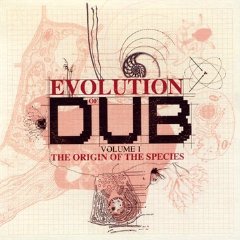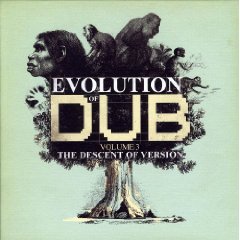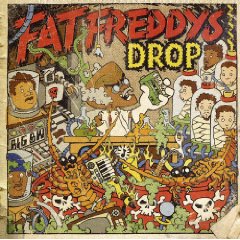Greensleeves was inspired by the Darwin year 2009 and is celebrating Charles Darwin's bicentenary with the Evolution Of Dub-Boxsets (Greensleeves / Groove Attack). At the moment contradicting information is circulating about whether four or seven boxes are planned. In any case, the fact is that I have three boxes: Vol. 1 - The Origin Of The Species, Vol. 2 - The Great Leap Forward and Vol. 3: The Descent Of Version. Each of these boxes contains four classic ones Dub-Albums in reprint of the original cover. With this, Greensleeves made it pretty easy, because instead of tracing the evolution on the basis of important pieces - which would have been a huge research and licensing work - they limited themselves to the re-release of a few albums. In a stupid way, however, evolution has to do without epoch-making works by z. B. Lee Perry, Yabby You, Augustus Pablo or Glen Brown get along, which makes the claim made by the title of the series seem quite questionable. Therefore, it makes more sense to present the series as a beautiful, classic collection Dub-To understand albums from the 1970s (maybe later also the 1980s?) And not worry about the evolution theory à la Greensleeves.
Let's take a closer look at these boxes. Vol. 1. begins with a small sensation, namely an ultra-rare work that is also one of the first Dub-Albums in general was: "Dub Serial ". Joe Gibbs published a minimal number of copies in 1972 and sold it for $ 50 apiece (a "normal" album at the time was around $ 4) primarily to sound system DJs. The wealthy listeners got a lot of well-known rhythms like “Satta A Massa Gana”, “Joe-Frazier”, “Money in My Pocket” or “Rainy Night in Georgia”, mixed spartan and with long drum & bass passages. The other three albums in the box were released by the then still young king of Dub, King Tubby, mixed: ""Dub From The Roots ”,“ The Roots Of Dub" and "Dubbing With The Observer ”. "Dub From The Roots ”and“ The Roots Of Dub“Were the first two LPs on which King Tubby was named as an artist. With black and white recordings of Tubby at the mixer prominently placed on the cover, they established the fame of the sound tinkerer. Tubby remixes the typical Bunny Lee-Mid-70ies “Flying Cymbals-Sound” on both albums, so that it is a pleasure. Especially in contrast to the two years older "Dub Serial “shows Tubby's mixing talent in full size. The 4th album, "Dubbing With The Observer ”, was of course penned by Winston“ Niney ”Holness and features some of his classic Dennis Brown rhythms like“ Cassandra ”,“ No More Will I Roam ”and“ I Am The Conqueror ”. Here, too, King Tubby provided pure Dub-Magic. Niney licensed the freshly mixed Dub-Album stante pede to England and sold just two years after the invention of Dub-Albums already considerable numbers. Dub had arrived overseas.
Box No. 2 begins with the album “Bunny Lee & King Tubby Present Tommy McCook And The Aggrovators - Brass Rockers” and presents what later became “Instrudubs "should be mentioned: Dubs with Overdubs. Bunny Lee delivered rhythm tracks like "A Love I Can Feel", "Dance In A Greenwich Farm" or "Dance With Me", which Tubby mixed Dubs from it and Tommy McCook then improvised his saxophone solos over it. This shows once again how unbeatably economical reggae functioned - and what innovations this economy brought about. While “Brass Rockers” was an experiment whose success could not be calculated, the box's second album, “The Aggrovators - Rasta Dub 76 ”, the ever-growing market Dub-Fan fans who stormed the record stores in droves and always wanted to hear the B-side of a Singe before the A-side. Tubby's name on the label sold the records. In this case, however, Tubby's mixing apprentice Phillip Smart drew for the Dubs responsible. While Smart, Prince Jammy and later also Scientist die Dubs mixing, Tubby could devote himself to the more lucrative activities, namely repairing televisions and radios. In the meantime it was Dub-Evolution arrived in 1977 and Bunny Lee (actually the series should better be called "The Evolution of Bunny Lee") rented the Channel One Studio to record "Aggrovators Meets The Revolutionaries At Channel One Studio". A very popular one Dub-Album with powerful rhythms, partly played by Sly Dunbar, in the outstanding sound of the Hookim studio. But the real attraction of the album is the fantastic horn section, which brilliantly garnished all pieces with its jazz improvisations and melody fragments. With the last album in this box, Niney has another chance: “Sledgehammer Dub". In the mid-1970s, each single came out with one Dub-B side. It didn't take long for this principle to be applied to albums, and so Niney released Sledgehammer in 1977 Dub" the Dub-Counterpart to Dennis Brown's "Deep Down" LP. Since Niney only sent around 400 pressings to England, which were also sold in an unprinted cover without a track listing, “Sledgehammer Dub“The most highly traded in auctions Dub-Works. Now the rare work is easily accessible - also a result of evolution.
Let's take a look at the last, third CD box so far. There are well-known ones in it Dub- albums that probably everyone Dub-Freund already has a vinyl LP on the shelf: 1. “The Revolutionaries: Negrea Love Dub", 2." The Revolutionaries: Green Bay Dub", 3." The Revolutionaries: Outlaw Dub", 4." The Revolutionaries: Goldmine Dub". It is obvious that towards the end of the 1970s the Revolutionaries and with them the Channel One studio were the leading authorities in the reggae business. And it's very beneficial that evolution has spawned other producers besides Bunny Lee. For example Linval Thompson, who produced the first three albums in this box and whose vocals keep flashing between the beats. The real star of these albums, however, is Sly Dunbar, who has his "Dubble drum sound ”to perfection. It was the time when the rhythms slowed down and got more "air". Actually, that started with ideal conditions for Dub, but in Jamaica the star of this genre was already falling. Not so in England, where Dub remained unbroken in popularity. It was a premonition of the current state in which Dub is a global but entirely un-Jamaican form of music. The fourth album in the set, “Goldmine Dub“, From 1979, was produced by Jah Lloyd and mixed by Prince Jammy. The mix, the sound and Sly Dunbar's playing are simply superb. The style was Jamaican Dub here at the peak. The then young label Greensleeves licensed “Goldmine Dub“And it was one of the first Greensleeves releases to hit record stores. But that's a different story of development ...
An album that also fits well into the “Evolution Of Dub“Would have been right "Pleasure DubBy Tommy McCook & The Supersonics (Pressure Sounds / Groove Attack), because the Dubs heard here are from the Treasure Isle studio - the place where Dub was invented. Bunny Lee describes the historic moment as follows: “Tubby and I met up at Duke Reid's studio, where sound man Ruddy Redwood and house engineer Byron“ Smithy ”Smith Dub Recorded plates. On one piece, Smithy forgot to turn on the vocal track in time because he was distracted by a conversation with Tubby and me. When he noticed the mistake and wanted to stop the recording, Ruddy only said: "No, make it run". The next day Ruddy played the song in the sound system and then put the "failed" Dub Plate up. People loved it and sang the song along with the mere rhythm track. Ruddy had to put the record on five or ten times. It was a huge success. ”In evolutionary terms, this was the moment that separated animate from dead matter - or the Big Bang of Dub, depending on your point of view. In any case, a moment in the Dub-Evolution cannot be missing, even if it is early on Dub Plates were only about "versions", i.e. unedited rhythm tracks. After the death of Treasure Isle boss Duke Reid, his nephew Errol Brown took control of the mixer and mixed three real ones from the old recordings from the 1960s Dub-Albums: "Treasure Dub Vol. 1 "and" Vol. 2 "and" Pleasure Dub". While the former has been rereleased many times, perhaps the best album of the three, “Pleasure Dub“, Patiently his rediscovery. Now it is available, the sound has been edited and six bonus tracks have been added. Of "Dub“There is not much to be heard on the album, for which one is secretly grateful, because a real one Dub Mixing would mean having to do without the wonderful arrangements of the Rhtyhm tracks, missing the grandiose wind or organ melodies or only hearing fragments of the typical, warm, full-sounding Treasure Isle sound. Fortunately - one can only say - he thought Dub-Big Bang on four-track tapes!
From the beginning of the Dub let's take a giant step into the present, where Noise shaper with the new album "Satellite City" (Cat'n Roof / Groove Attack) describes the current status quo of the genre. And this is already beyond the narrow limits of reggae. But the heart of the Dub - the deep groove, warm sound and melodic bass - still hits in the right place, which is why genres such as soul, deephouse, electronic and reggae come together organically and naturally into a big whole on Satellite City: to Dub 2009! The ten fresh tracks by Axel Hirn and Flo Fleischman sometimes sound like On U-Sound, sometimes like Dubhouse à la Rhythm & Sound, sometimes leftfield and mostly different drummer - and they always have a casual pop appeal, which is not insignificantly brought in by the committed guest vocalists such as Juggla, Jackie Deane or Wayne Martin. I especially love Noiseshaper for their deep shuffle beats, like him z. B. on the song "Sod's Law". Here it is congenially complemented by soft female soul vocals. Dub can be so much. In the course of its evolution it has developed less into a specific musical style in an economic niche than much more into a universal principle that permeates a multitude of musical genres.
This thesis can also be seen very nicely on the new album "Dr. Boondigga & The Big BW "(The Drop / Roughtrade) by Fat Freddy's Drop prove. After the Freddys released their debut album "Based On A True Story" in 2005 with vehemence from far-away New Zealand into the local field of perception Dub Enthusiasts and thus achieved an unprecedented commercial success, now follows the high-expectations successor. But the New Zealanders escaped the almost four-year pressure of expectation simply by doing what for Dub (according to Axel Hirn from Noiseshaper) actually stands: You broke the conventions and consequently now deliver an album that disappoints, surprises, enthuses. They themselves describe their music as "Beat Reduction & Sonic Fine-tuning" and let it change stylistically between blues, electronics, reggae and funk. If it weren't for the latent effect Dub-Principle that holds the very different tracks together, then we would have a very disparate compilation here. But in this way - and especially through the ingenious dramaturgy of the song sequence - a highly interesting, demanding and inspired album is created, which in the end is perhaps a logical further development of "Based On A True Story".







2 replies to "Dub Evolution, August 2009 "
Got all three Dub Evoluiton Editions and I'm pretty excited because there are real rarities under it. There are far better ones Dub LP's but here the mix and the great design of the boxes gives the necessary flavor ...
The 4th edition will be out in September and has already been pre-ordered ...
Bless
When Vol. 4 is available, there will of course be an update here.